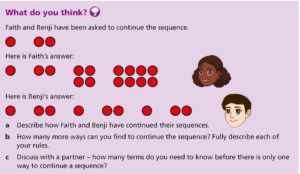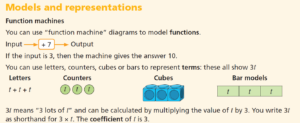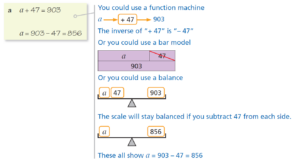It’s never easy for students to move from Year 6 to Year 7. For the vast majority, they move from being the biggest fish in a little pond to small fry in what feels like an ocean! Add to that the fact that their last two years of primary school have been severely disrupted by the global pandemic and some new Year 7s may be feeling the pressure more than ever this year. So how can the Collins White Rose Maths series for Key Stage 3 help to smooth the transition?
It starts with something new
Unlike many schemes of learning, the White Rose Maths secondary schemes start with Algebraic Thinking rather than number. Although students may have met algebra briefly in Year 6, they won’t have covered it in detail, so this provides a clean slate and something fresh and exciting – especially for those students who have been struggling with arithmetic, possibly for several years. It’s also about algebraic thinking rather than just complicated use of symbols and designed to allow students to spot patterns and think creatively alongside their new learning. Here’s an example from the first section of the book:

There are so many possible answers to this question and it helps students to see that maths isn’t just about being right or wrong, but also about being imaginative and resourceful.
The focus is on understanding the maths
You need to be fluent and accurate to succeed in maths, and it’s much easier to do so if you understand what you’re doing. The Collins White Rose Maths books support understanding using “concrete manipulatives” – objects that help students to make sense of the maths they’re doing. Ideas for these, and for pictorial representations too, are provided at the start of every chapter of the books for the whole of Key Stage 3. Here’s an example for when algebraic notation is introduced in the second block of the book.

The models and representations are then used throughout the book to help students to understand things like “collect like terms” as shown in this worked example:

A cube symbol is then used in the exercises to show when manipulatives might be useful for students to use to help answer the questions, like this:

As you can see there’s a lot of practice too! Questions have been chosen carefully to consider what to vary and what to keep the same so students’ attention is drawn to the key points of learning.
Calculators are allowed!
A key feature of primary school maths learning is to get a secure grounding in number work, and although this is continued in the White Rose Maths Key Stage 3 scheme, it’s important that students learn how to use a calculator too, so this is another key new feature for students to enjoy as they start at their new schools. Here are some examples from the Algebra section from Student Book 1:

As well as removing the possible fear of getting the answer wrong because of number work, this approach again helps students’ understanding by making them think about the relationships shown in an equation. If they are only presented with equations of the type “x + 4 = 10” where they can “spot” the answer x = 6, they don’t appreciate the inverse relationship of addition/subtraction they need to solve more complex equations. You can also see there’s a bar model symbol next to these questions. Most students will have met bar models in primary schools – definitely if they’ve followed the White Rose Maths primary schemes – so this is another useful support for transition as well as pictorial support for students to understand the relationships. Again these are illustrated in the textbook to help students understand.


Opportunities for learning calculator skills are then built-in throughout the rest of the book, and the Key Stage 3 series.
Becoming confident mathematicians
The White Rose Maths ethos is to support students to become confident, independent mathematicians. By creating a scheme and series of textbooks that build on their learning from primary school, using familiar approaches to increasingly complicated maths in fresh and exciting ways, we believe that students’ transition to secondary school will be much smoother. They’ll also have a much more positive attitude to maths and be more resilient as they’ll have bank of strategies and approaches they rely on when things get hard. The White Rose Maths motto is #MathsEveryoneCan and the Collins White Rose books will definitely help students on their way!
By Ian Davies & Caroline Hamilton, series editors of White Rose Maths for Key Stage 3
Find out more about White Rose Maths and view their free schemes of work
Liked this? Read more Secondary Maths articles



